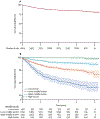The Global Retinoblastoma Outcome Study: a prospective, cluster-based analysis of 4064 patients from 149 countries
- PMID: 35839812
- PMCID: PMC9397647
- DOI: 10.1016/S2214-109X(22)00250-9
The Global Retinoblastoma Outcome Study: a prospective, cluster-based analysis of 4064 patients from 149 countries
Abstract
Background: Retinoblastoma is the most common intraocular cancer worldwide. There is some evidence to suggest that major differences exist in treatment outcomes for children with retinoblastoma from different regions, but these differences have not been assessed on a global scale. We aimed to report 3-year outcomes for children with retinoblastoma globally and to investigate factors associated with survival.
Methods: We did a prospective cluster-based analysis of treatment-naive patients with retinoblastoma who were diagnosed between Jan 1, 2017, and Dec 31, 2017, then treated and followed up for 3 years. Patients were recruited from 260 specialised treatment centres worldwide. Data were obtained from participating centres on primary and additional treatments, duration of follow-up, metastasis, eye globe salvage, and survival outcome. We analysed time to death and time to enucleation with Cox regression models.
Findings: The cohort included 4064 children from 149 countries. The median age at diagnosis was 23·2 months (IQR 11·0-36·5). Extraocular tumour spread (cT4 of the cTNMH classification) at diagnosis was reported in five (0·8%) of 636 children from high-income countries, 55 (5·4%) of 1027 children from upper-middle-income countries, 342 (19·7%) of 1738 children from lower-middle-income countries, and 196 (42·9%) of 457 children from low-income countries. Enucleation surgery was available for all children and intravenous chemotherapy was available for 4014 (98·8%) of 4064 children. The 3-year survival rate was 99·5% (95% CI 98·8-100·0) for children from high-income countries, 91·2% (89·5-93·0) for children from upper-middle-income countries, 80·3% (78·3-82·3) for children from lower-middle-income countries, and 57·3% (52·1-63·0) for children from low-income countries. On analysis, independent factors for worse survival were residence in low-income countries compared to high-income countries (hazard ratio 16·67; 95% CI 4·76-50·00), cT4 advanced tumour compared to cT1 (8·98; 4·44-18·18), and older age at diagnosis in children up to 3 years (1·38 per year; 1·23-1·56). For children aged 3-7 years, the mortality risk decreased slightly (p=0·0104 for the change in slope).
Interpretation: This study, estimated to include approximately half of all new retinoblastoma cases worldwide in 2017, shows profound inequity in survival of children depending on the national income level of their country of residence. In high-income countries, death from retinoblastoma is rare, whereas in low-income countries estimated 3-year survival is just over 50%. Although essential treatments are available in nearly all countries, early diagnosis and treatment in low-income countries are key to improving survival outcomes.
Funding: Queen Elizabeth Diamond Jubilee Trust.
Copyright © 2022 The Author(s). Published by Elsevier Ltd. This is an Open Access article under the CC BY 4.0 license. Published by Elsevier Ltd.. All rights reserved.
Conflict of interest statement
Declaration of interests We declare no competing interests.
Figures


Comment in
-
Retinoblastoma as a lens for correctable disparities worldwide.Lancet Glob Health. 2022 Aug;10(8):e1074-e1075. doi: 10.1016/S2214-109X(22)00290-X. Lancet Glob Health. 2022. PMID: 35839799 No abstract available.
References
-
- Kivelä T. The epidemiological challenge of the most frequent eye cancer: retinoblastoma, an issue of birth and death. Br J Ophthalmol 2009; 93: 1129–31. - PubMed
-
- Canturk S, Qaddoumi I, Khetan V, et al. Survival of retinoblastoma in less-developed countries impact of socioeconomic and health-related indicators. Br J Ophthalmol 2010; 94: 1432–36. - PubMed
-
- Bas Z, Dalvin LA, Tadepalli S, et al. Outcomes of intravenous chemotherapy (chemoreduction) for retinoblastoma based on patient age in 964 eyes of 554 patients. Asia Pac J Ophthalmol 2021; 10: 373–80. - PubMed
-
- Fabian ID, Stacey AW, Johnson KP, et al. Primary intravenous chemotherapy for group D retinoblastoma: a 13-year retrospective analysis. Br J Ophthalmol 2017; 101: 82–88. - PubMed
Publication types
MeSH terms
Grants and funding
LinkOut - more resources
Full Text Sources
Medical
Research Materials

